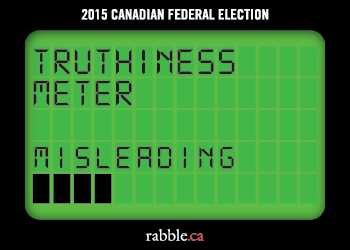Want to see an election campaign fact rich and spin poor? Chip in to keep our fact check blog up to date.
The claim: The Liberals will help post-secondary education students by expanding student aid
The Liberals have promised to increase income thresholds to allow college and university students to access larger grants through the Canada Student Grant program. This will cost an additional $750 million per year for student grants (up to $850 million when fully implemented).
Currently, students in all provinces and territories except Quebec, Nunavut and the Northwest Territories are eligible for the Canada Student Grant. To apply, you had to have also applied for student loans; you can’t only apply for the grant.
The low-income family grant provides students will $250 per month, to a maximum of $3000. If you’re eligible for the maximum grant, you’re likely to also owe the maximum in student loans, capped in Ontario at $7,400 per year, if you’re in a two-semester program. Over four years, this translates into a student debt of nearly $30,000, compounded by interest. You can pay if off over 15 years.
The Liberals also promise to halt loan payments until people earn more than $25,000, a useful back-end way to allow people to delay paying off their student loans, in the anticipation that they will eventually make enough money to pay it back.
Higher education is a sector where the provinces and the federal government have shared jurisdiction. Without dedicated transfer payments to the provinces specifically for higher education, the impact of any grants program will vaporize, unless the provinces agree to stop increasing tuition fees.
Average university tuition fees in Canada are $6,100 per year. This ranges from Ontario’s high average at nearly $7,900 to Newfoundland and Labrador’s low at $2,660. As fees have continued to climb, so too have the costs of maintaining a debt-funded system: since 2011, the Canada Student Grant program has increased by 6.1 per cent and the total maximum allowable debt that the Government of Canada can loan was increased from $19 billion in May to $24 billion.
The Federal Liberals are mostly to blame for this debt crisis. Despite not having been in power for nine years, cuts made to federal transfer payments under Jean Chrétien fundamentally shifted how higher education is funded in this country. When $4 billion was taken out of the system, it sent a signal to every province to use tuition fees to help balance provincial books, and tuition fees shot up.
The national system of loans and grants are extremely complicated, in fact, the CCPA’s report comparing provincial systems was titled: It’s Complicated. Considering this, and considering the huge disparities that exist from province to province, a $750 million injection into higher education will help some students, but focusing solely on grants compounds the problems plaguing the system, rather than fixing them.
Verdict:

Want to see an election campaign fact rich and spin poor? Chip in to keep our fact check blog up to date.
Image: Democracy Now



